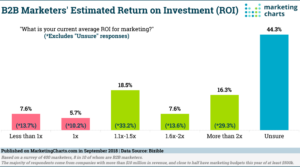Better Marketing
Is Marketing ROI a Key to Profitability?
A sustainably profitable business is what we’re all looking for, and it makes sense that profitable marketing, would help you achieve that.
Most people would agree. But trying to define ‘profitable marketing’ forces us to think a little deeper about what it might actually entail, and how it can be achieved.
Despite all the data we can access there are still some aspects of your marketing that are virtually impossible to measure but still make a huge contribution to the sustainability of your business, your profitability and – at the end of the day – its value.
That’s right, there are still plenty of business activities obviously worth doing even if you can’t directly measure them. (Of course, if you think about it, that applies to many aspects of your operation).
And it equally applies to businesses that spend hundreds of millions on marketing, despite them spending heavily on measurement, analysis and optimisation.
“If you want to drive into the desert take a Land Rover, but if you want to come back take a Landcruiser.”
A mechanic friend said that to me years ago when I was looking at buying a 4WD, and I’ve heard it since then too. Ask any mechanic the world over, they’ll tell you Toyota 4WDs are the most reliable vehicles on the planet.
With this global word-of-mouth reputation, have they stopped advertising? Most certainly not.
Now we know that for smaller businesses, it’s pretty difficult to justify spending on something you can’t directly measure a result from, but if it didn’t work would the Coca Cola brand be worth 97.9 billion dollars? (Source: Statista). Would Disney, Apple, IMB Accenture, Microsoft and Toyota even bother at all?
OK, perhaps that all sounds a bit vague, so let’s lay out the true value of marketing
for you right now.
And let’s not beat around the bush, what we’re actually asking is….
…. is marketing really worth it?
I think, to be honest, if you’re asking that question then you’re probably not thinking about it correctly or fully considering how marketing impacts your business, because if you were you’d be seeing the benefits, measurable and otherwise.
Which isn’t unusual as it’s pretty difficult to get it all working right, especially in a small business.

But let’s play this with a straight bat and answer the question as best we can…. Here are five ways marketing can help your business, whether a ROI or profitability impact is measurable or not…
1. Marketing helps create internal alignment
When you identify and articulate why your business exists and what is the business’ purpose of your business, that’s marketing. When you clearly define the promise your business makes to its team, customers and prospects, that’s marketing too. And when you communicate all of that internally… yep, marketing, in fact marketing on the inside of your business is one of the most important kinds of marketing there is.
By communicating all of that to your employees, you’re not only getting everyone on the same page with exactly why you exist and what and how your business does better than anyone else, you’re also involving them in the thinking behind it, engaging them in your purpose, and motivating everyone to pull in the same direction.
So what’s the marketing ROI on harnessing that kind of energy? It’s certainly not measured in clicks or likes, it’s going to be hard to sheet it directly back to revenue, profitability and growth. But we’ve seen what we call ‘Marketing on the Inside’ absolutely transform the energy and effectiveness of operations….. people seem to have smiles on their faces, the co-operate better, employee turnover reduces, and when you need to recruit more people, you’ll find you attract better people more easily.
“75% of active job seekers are likely to apply to a job if the employer actively manages its employer brand.”
Source: Glassdoor
2. Marketing helps you sell more to existing clients
Got enough clients already..? Not sure you need marketing? What would your bottom line look like if you could extract an additional 10% of yield from each existing client? There’s not many a business owner who’d refuse that opportunity … and yes, you guessed it, that’s marketing too.
If you keep adding value for your existing clients through a communication program, build relationships and look for additional ways to help, you’re going to make more sales. By telling them about all the different aspects of your business, you may even end up cross-selling other products or services they weren’t aware of.
Creating a remarkable client experience is marketing, and if you’re purposeful about it, refine the process and then standardise it across the board, you’ll actually be able to measure the marketing ROI on this kind of activity…. Result!
3. Marketing helps attract completely new customers
This is the area people think about first whenever marketing is mentioned, and yes – marketing ROI is pretty important when your aim is to generate leads and convert them into sales.
But how does a sale actually get made. In the B2B world where there are an average if 6 touch points per sale, this is not a simple question. But let’s boil it down to two marketing tools: brand and digital.
Brand Marketing
Here’s a side of marketing that is difficult to measure but fundamentally important nonetheless.
Brand marketing is when you promote your business without actually asking for the sale. So, almost every single Coca Cola advert you’ve ever seen, for example, from teaching the world to sing all the way through those polar bears.
It creates awareness of and preference for your brand, or product, so that when a person is in the position to buy, they’re more predisposed to pick you, and not one of your competitors.
I don’t know who you are.
I don’t know your company.
I don’t’ know your product.
I don’t know your customers.
I don’t know your company’s record.
I don’t know your company’s reputation.
Now, what was it you wanted to sell me…?
This is the copy from a decades-old ad for B to B research company Dunn & Bradstreet, and it demonstrates the power of brand marketing pretty well, don’t you think?
Besides, if you sponsor your local netball team, you’re engaging in brand marketing.
Will you get business from it..? Maybe, maybe not, but if a prospect also has a daughter in the team and they’re faced with a decision on who to select as their provider, it’s going to go in your favour. If a bright young local sales gun needs a job, they might contact you. What’s the ROI of that?
Who knows, but you can thank Brand marketing, for it!

Digital Marketing
You’ve built your brand, refined your messaging and developed a website, then it’s time to create some campaigns that tell your prospects how you can help them – and welcome them through the front door with their wallets open.
This is where you can measure the market response to virtually everything you do. What messages, webpages or ads are performing the best? Tweak them, throw them back into the wild, see if they’re even better. Constantly monitor the response, spend more when it works, cut back when it doesn’t, and you’re onto a winner.
A word of caution, however, this can take time. And if you give up before it starts to pay off, you’ll have wasted all that time and money for nothing. This is the reason many business owners begin to question the value of marketing, but if you hang in there, and you’ve got your strategy right it will pay off in the end.
Marketing is about consistency, and the longer your message is out there the more it will cut through. And once it does the results tend to be exponential, while your costs remain linear. So if you can hold on for that to happen, then your marketing effectiveness is going to be spot on.
How does this translate to ROI? Well, depends on your business. If you sell via the web it’s easy.. you can track purchases back to click-source. If leads get passed to a sales department to be progressed and closed, well that introduces a range of variables that are outside the remit of marketing, so you’ll have to be content with measuring leads.
4. Marketing helps you stay ahead of the game
Another important payoff from marketing that’s not considered very often is that it provides a constant source of response data coming back from your market, your customers and – if you keep your eyes open – your competitors too.
What’s the marketing ROI on monitoring your competitors, noticing a shift in positioning to impinge on your territory, and reacting accordingly? Simply put, it’s invaluable.
And, if you have a range of active campaigns out there doing their thing, sending back data on customer activity, then you’re constantly in touch with what’s going on.
Do you ever talk to your customers and ask if there’s anything else they need, or that you could do better? That’s marketing research, and as well as deepening the relationship with your clients it might even lead to new products or services.
5. Marketing helps you enter new markets
You want to expand your offering, a new product or service or enter a new territory. The only sure way is to start marketing into the new market, but there’s a risk that comes with that, so how can you minimise the investment to do so?
If your marketing has followed the mantra – as it should – “Test and learn, test and learn” then you’ll have well-developed channels that connect you to a segmented market. You’ll have processes for developing and testing messaging and you’ll know what media channels work best for you. You can see how that gives you a rapid, efficient path to market.
Once again what’s the marketing ROI on all that..? Ask Apple how the iPhone went…
So how do you actually calculate marketing ROI?
While there are several different ways to calculate marketing ROI, the core formula used to get a basic understanding of wholistic marketing impact at a high-level is relatively straightforward:
(Sales Growth – Marketing Cost) / Marketing Cost = Marketing ROI.
It’s important to note that this formula makes the assumption that all sales growth is tied to marketing efforts. If you take our point about the internal value of marketing, there’s a case for this. Some people try to remove organic sales (as opposed to those generated by marketing), but it can be very hard to make the distinction.
Marketers can also calculate ROI through tracking customer lifetime value (CLV) – the revenue you can reasonably expect an average customer to generate for your company throughout their relationship with you. This sheds light on the value of each individual customer relationship with a brand.
The formula is simply customer value multiplied by the average customer lifespan. To get to ‘customer value’, calculate the Average Purchase Value and then multiply that number by the average number of purchases.
So, can marketing prove its worth?
What do you think? Yes, we’re a marketing business and we’re talking about the value of marketing, but if you’ve read this far then surely, you’d agree it’s impossible to deny the benefits of staying on top of it. And hopefully you see the limitations of the idea of allocating ROI just to your market-facing campaigns when in reality, marketing is so much more than just running an ad campaign or posting on social. In fact do it right and it’s an essential driver of the entire business.
We didn’t say profitable marketing is easy, either in the doing OR the measuring, but we can definitely help with getting you there on both fronts.
If you need a hand pulling all of it together, or just some friendly advice, then we’d love to chat.



